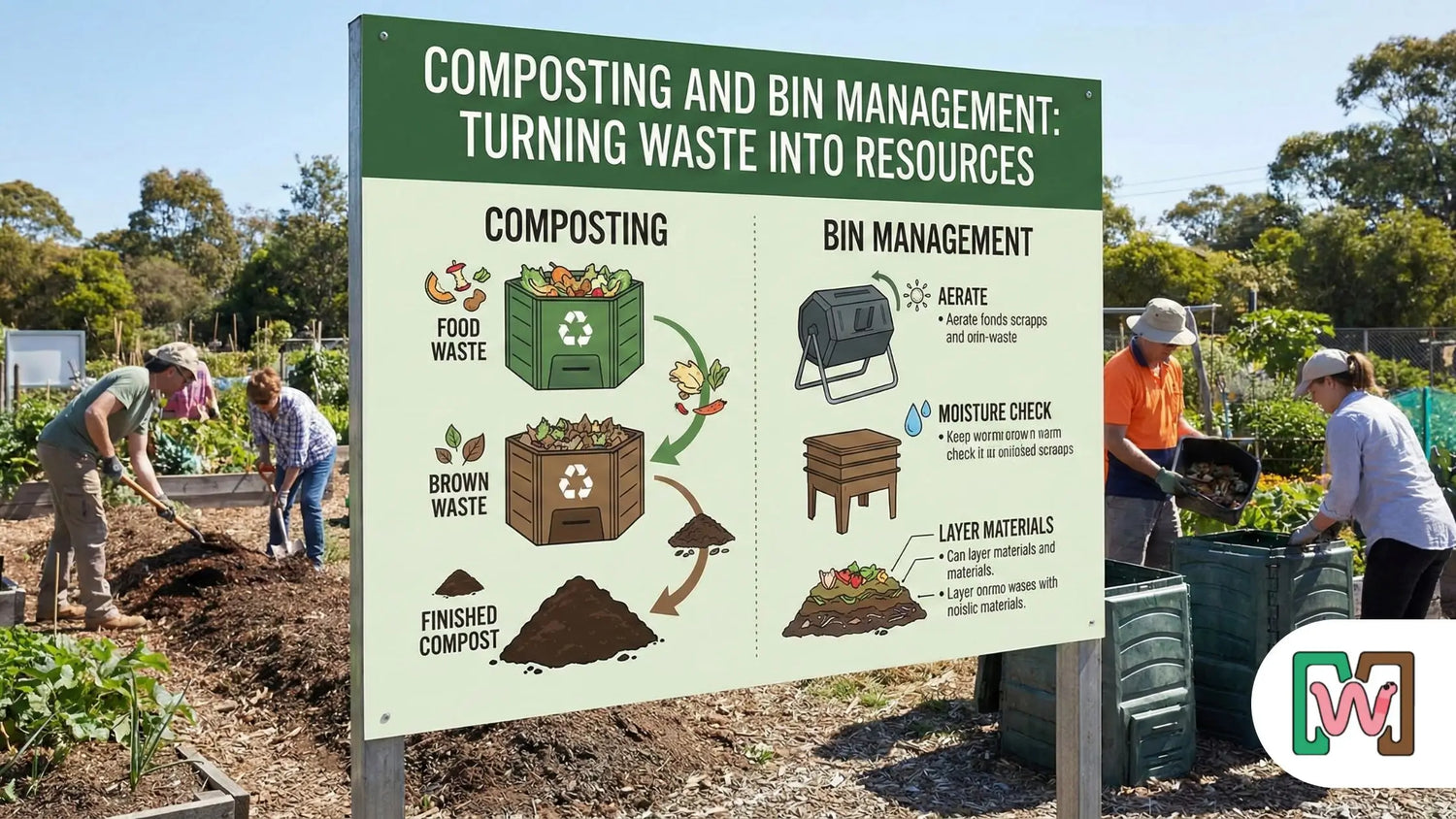What Is Bin Composting
Bin composting in its entirety happens within a container/bin. You can use a bucket, a plastic drum, an earthen pot, or any other box with proper ventilation for airflow. It is a very simple way to turn kitchen scraps into fertilizing materials - with the help of worms. As the microbes start breaking down the food, heat is released in the bin and it turns everything soft and soily.
Every household can do this, being rural or urban. Always check the moisture built up and add waste accordingly. Remember to keep insects away from the bin. Now, let us know more about the benefits of composting, the overall composting process in detail, types of composting, and how to compost at home.
Benefits of Composting
The benefits of composting & bin management are major. Here are. the top fifteen -
-
Food waste is lessened and organised within a managed bin. It reduces unnecessary wet-waste clutter.
-
A managed composting bin controls odor better than open trash disposal of household garbage.
-
A maintained (sealed and balanced) composting bin prevents pests and insects like flies, rodents, and ants away.
-
A well-maintained bin speeds up decomposition when moisture is controlled and airflow is sufficient - the microbes can break down the waste more effectively.
-
The process of composting itself enhances soil health to it’s max - by improving it’s structure and organic matter that which helps in excellent root growth.
-
Composting boosts the soil’s moisture retention.
-
There is no need for chemical fertilisers as the healthy compost provides nutrients naturally.
-
This gives support for sustainable waste management habits.
-
A well-maintained bin reduces contamination while recycling.
-
It facilitates an overall improvement cleanliness of the home waste system
Must Read : Types of Worms for Composting

The Composting Process Explained Simply
Let us understand the composting bin management process and ease out the complexities.
Step 1. Accumulate the waste to be composted
Your everyday kitchen waste can be a part of your compost bin. A lot of things that are normally thrown away as wet waste are - vegetable peels, apple cores, banana skins, leftover tea leaves, wilted flowers, or cracked eggshells.
Even though they might not have any utility in the normal human life, each of these discarded items is full of moisture and nutrients - therefore, best for your compost.
Step 2. Add some brown things
Do you have to add everything that is brown? No - just the ones that will decompose. Such as - dry leaves, cardboard pieces, newspaper strips, coconut fibre, and/or sawdust in a tiny amount.
They decompose themselves and help the greens decompose by maintaining the moisture amount and aeration. Ideally, first apply the ‘green’ layer,1 then top it off with the ‘brown’ layer.
Step 3. You have a working bin!
With the green and brown unity, decomposition happens, and microbes are formed. These organisms are microscopic and cannot be seen with the naked eye. They break down the food waste to make the soil extremely fertile. With the decomposition starts the building up of heat.
Step 4. Always manage the bin’s moisture
While managing a bin, it is important to remember that if the compost has too much moisture it will be smelly and attract a lot of pests. However, if it’s too dry and devoid of moisture, the microbial breakdown will halt and won’t come to fruition.
Thus, a tip -
- If it's too wet - add browns.
- If it's too dry - add greens.
Step 5. Turning or mixing the compost periodically
Every once a week, you should mix the bin a little to ensure cross ventilation. Air helps the compost break down faster and helps with the odor formation too. You can use a garden fork, a long stick, or even your own gloved hand to do so. It is the most crucial part of the composting bin management process.
Step 6. The Decomposition Stage
When every effort comes to play, the result is a successful decomposition. The bin turns darker, and the masses are smaller. The texture is softer than before, the odor is way less, and the heat is less. These are the signs of a successful composting process.
7. Reaching the Final Stage (Finished Compost)
After a few weeks to a few months, the compost reaches the finished stage.
You can tell your composting bin is ready when:
- It is dark brown
- It feels like soil
- It smells earthy
- The original food scraps are vanished
8. Using the Compost
You can use compost in:
- Potted plants
- Home gardens
- Lawns
- Flower beds
- School garden projects

Types of Composting
There are many types of composting.
Hot composting works quickly because the pile heats above 131° Fahrenheit. It needs turning. It needs attention. People who want fast results often choose this method.
Cold composting works on its own. You add waste over time and let it sit. It takes months. Sometimes longer. Yet the effort is minimal.
Vermicomposting relies on special worms that eat organic matter. People who want softer, richer compost choose this method. It stays cooler than hot composting. The worms do the work quietly.
Bin composting falls somewhere in the middle. It can act like a slow system or a fast one depending on what you feed it and how often you turn it. For many city households, this becomes the most practical method for how to compost at home.
Bokashi is when the food scraps are fermented as a part of the pre-process. The fermented waste is neat, odor-controlled, and good for small spaces.
Must Read : How Long Do Worms Live
Composting and Bin Management Basics
Composting bin management depends on climate, feed quantity, airflow, and even the type of bin.
Moisture control comes first. The mix should feel like a wrung-out sponge. Not dripping. Not bone dry. This one-touch test can save beginners a lot of trouble. Too much water suffocates microbes. Too little stalls decomposition.
Next, for composting waste management, comes aeration. Turning the pile once a week or punching holes through with a stick lets air circulate. A compost bin with proper airflow heats evenly. Anaerobic pockets reduce.
Then comes the carbon and nitrogen balance. Kitchen waste carries nitrogen; therefore, the composting of solid waste becomes necessary. Dry leaves carry carbon. You do not need exact ratios. You only need to observe how the bin behaves. If it smells sweet and earthy, you are close to the right mix. If it smells sharp or rotten, add more browns.
Pest management also fits into compost bin management. Ants visit dry bins. Flies visit wet bins. Rats appear when large food chunks are left out. Tight lids prevent trouble. Smaller scraps break down faster.
Choosing the right bin size matters too. A bin that is too small fills quickly and overheats. A bin that is too big stays cold. Most homes manage well with a 4-6.5-gallon container for daily waste and a larger working bin for the active composting stage.
Composting Waste Management in Urban Homes
Urban composting bin management plays a much larger role than people realise. Solid waste management systems struggle with food scraps. They rot fast. They attract animals. They release methane in landfills. When households handle composting of solid waste at home, the load on municipal systems drops. Neighbourhoods stay cleaner. Garbage trucks deal with lighter waste streams.
A single home does not make a huge difference in a city. But many homes do. Apartment complexes that compost in community bins often notice the shift within weeks. Fewer mixed waste bags. Lower garbage bills. Better gardens. Cities abroad have run compost bin management programs for decades. Cities are slowly catching up. The habit grows one bin at a time.
Conclusion
Composting bin management becomes easier when the bin becomes familiar. At first it feels like a chore. Then the waste begins to transform. You start noticing how tiny adjustments change the smell, the heat, the texture.
Composting & bin management blend into daily life. And somewhere in that slow, steady cycle, the kitchen scraps that once felt like clutter turn into something almost gentle. Something the soil understands.
👉🛒 Shop Worm Bins for Sustainable Composting




Leave a comment
All comments are moderated before being published.
This site is protected by hCaptcha and the hCaptcha Privacy Policy and Terms of Service apply.